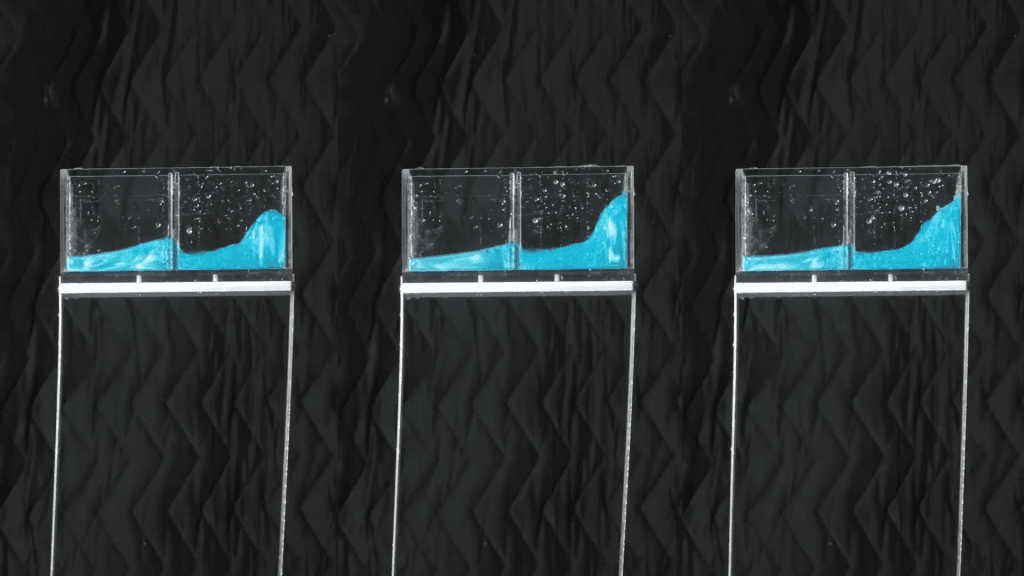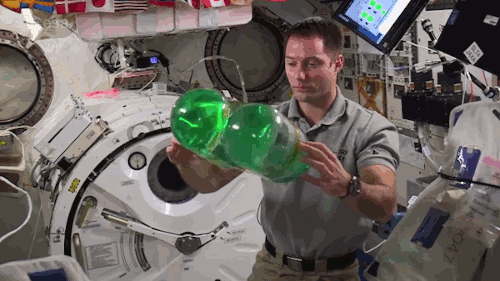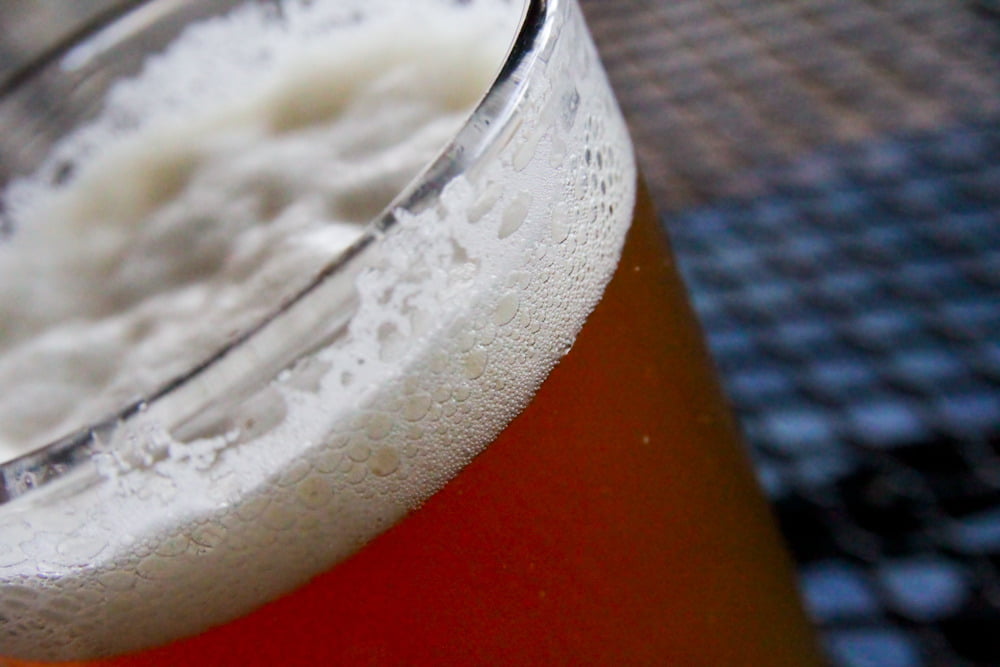Wind forces on a skyscraper can set it swaying, so engineers design dampers to stop the motion and keep users comfortable. Some buildings use suspended solid mass dampers to counter a building’s motion, but others take a liquid approach. Whether by shifting water through specially shaped chambers or by sloshing it back and forth in a tank, a tuned liquid damper system can quickly bring a building back to rest. In this Practical Engineering video, Grady discusses the challenges of designing these systems and demonstrates how they work with a cool tabletop version. As a reminder, sloshing also helps in water-bottle flipping and stopping a bouncing ball. (Video and image credit: Practical Engineering)
Tag: sloshing

Prehistoric Seiche
Sixty-six million years ago, a meteorite impact in modern-day Mexico wiped out the dinosaurs and most other living species of the time. To call the event catastrophic feels like an understatement. At the site of impact, rocks and animals were vaporized. Further away, molten rock condensed into glass beads that form a geological layer found around the world.
Still further away, in what is now North Dakota and was then the bank of a freshwater river, scientists have discovered a deposit full of saltwater fish, sharks, and rays that would have lived in the vast inland sea (A) that stretched northward from Texas. The meteorite’s impact pushed these creatures kilometers upstream against the river’s natural flow.
One possible explanation for the inundation is a tsunami. But geological evidence indicates the deposit took place within 15 minutes to two hours of the impact, when glass beads were still raining down. To travel the 3,000 km from the point of impact would take a tsunami on the order of 18 hours – far too long.
Instead, the deposit is likely the result of a seiche (pronounced “saysh”) – a type of standing wave that occurs in an enclosed or partially enclosed body of water. If you imagine water sloshing in a cup or a tub, that’s essentially what a seiche is, but this was on a much larger scale. (For an example, check out this insane footage of an earthquake-induced seiche in a swimming pool.)
What set the seiche to sloshing are the seismic waves triggered by the meteorite impact. They would have reached this site 6-13 minutes after the impact and triggered waves on the order of 10m. As the waves drove up the riverways, they carried dead and dying sea creatures with them, leaving them stranded on the riverbank until scientists uncovered them tens of millions of years later. (Image and research credit: R. DePalma et al.; via The Conversation; submitted by Kam-Yung Soh)

Water Bottle Flipping Physics
In 2016, a senior talent show launched a new viral craze: water bottle flipping. As improbable as it seems at first glance, physics is actually on your side when it comes to pulling this trick off. As explained in this classroom-oriented paper and the video abstract below, the sloshing of the water in the bottle as it flips slows its rate of rotation, which creates the stable landing. You don’t even need water to make the trick possible. Using two tennis balls will also give a stable flip – provided they have room to spread out. When they fly apart, they change the bottle’s moment of inertia and that slows down the rotation rate. All in all, it’s a great lesson in conservation of angular momentum.
And, in case you’re wondering whether the water helps with sticking that landing, we’ve got you covered there, too. (Image credit: A. Johnson, source; video and research credit: P. Dekker et al.)

Stopping a Bounce
One way to damp a bouncing ball is to partially fill it with a fluid (a) or granular material (b). For the fluid, the initial impact sloshes the liquid. That doesn’t change the trajectory of the initial bounce noticeably, but it interferes with the second impact, drastically damping the rest of the ball’s bounces until it comes to a stop. A grain-filled ball is similar, at least to begin with. The initial bounce sends the grains flying, forming a granular gas inside the ball. This doesn’t affect the trajectory of the first bounce, but the second impact collapses the granular gas. All the impacts of the grains with one another dissipate the energy of the bounce, and the ball comes to a complete stop. This suggests that a partially-grain-filled container can make a good damper in sport or industrial applications. It also suggests that it might be even better for water-bottle flipping than water is. (Image and research credit: F. Pacheco-Vázquez & S. Dorbolo)

Sloshing in Space
Last month, French astronaut Thomas Pesquet posted a video of some experiments he did on the International Space Station exploring the movement of fluids in microgravity. He filmed the experiments as part of the SPHERES Slosh project. Sloshing is the technical term for how liquids respond to the motion of their container, and it’s a tough problem whether you’re carrying a full coffee mug on Earth or dealing with a partially-emptied fuel canister in orbit.
Here on Earth, gravitational forces dominate how fluids respond, but in microgravity, surface tension is a more powerful player. Pesquet’s demonstrations help scientists here on Earth better understand and model how liquids respond to movement in space. One major application for this is in spacecraft fuel tanks, which engineers must be able to design so that they empty themselves consistently with or without the added complications of spinning, maneuvering, or impulsive kicks of acceleration. (Video and image credit: ESA; submitted by gdurey)


Water Bottle Flipping Physics

Water bottle flipping has become quite the craze, and in a recent video The Backyard Scientist presented his own take on the subject, testing whether you could flip a bottle with mercury rather than water. As it turns out, fluid dynamicists have studied this topic, too, by dropping partially-filled elastic spheres containing water, isopropyl alcohol, and glycerin. The key physics here comes from the sloshing of liquid inside the container. When the elastic ball bounces, energy that would otherwise go into the sphere’s rebound instead gets distributed into sloshing the fluid inside. The result is that the sphere bounces less on its subsequent impacts.
Interestingly, the researchers found that the properties of the fluid inside the ball made very little difference to its rebound height. Instead, the most important feature was the volume of fluid in the container. Balls filled to approximately 30% of their volume had the most damping – that’s totally consistent with the best water bottle flips, which use bottles about 1/3rd full.
The main difference between flipping a bottle and dropping a ball is what goes on in the first bounce. When a bottle hits a surface, the liquid inside has already been disturbed by the bottle’s rotation. For a ball being dropped, that first impact is what disturbs the fluid. So while a water-filled ball’s first rebound will reach nearly the same height as an empty ball, the spinning water bottle is, in effect, already on its second bounce. The motion of the fluid inside the bottle acts as a damper, allowing the bottle to stick the landing. (Image credit: Mercury Bottle Flip – The Backyard Scientist, source; Water Ball Bounce – The Splash Lab, source; research credit: T. Killian et al.)

Stopping the Slosh
Sloshing is a problem with which anyone who has carried an overly full cup is familiar. Because of their freedom to flow and conform to any shape, fluids can shift their shape and center of mass drastically when transported. The issue can be especially pronounced in a partially-filled tank. The sloshing of water in a tank on a pick-up truck, for example, can be enough to rock the entire vehicle. One way to deal with sloshing is actively-controlled vibration damping – in other words, making small movements in response to the sloshing to keep the amplitude small. This is exactly the kind of compensation we do when carrying a mug of coffee without spilling. (Image credit: Bosch Rexroth; source)
Instability
[original media no longer available]
Many systems can exhibit unstable behaviors when perturbed. The classic example is a ball sitting on top of a hill; if you move the ball at all, it will fall down the hill due to gravity. There is no way to perturb the ball in such a way that it will return to the top of the hill; this makes the top of the hill an unstable point. In many dynamical systems, a very small perturbation may not be as obviously unstable as the ball atop the hill, especially at first. Often a perturbation will have a very small effect initially, but it can grow exponentially with time. That is the case in this video. Here a tank of fluid is being vibrated vertically with a constant amplitude. At first, the sloshing effect on the fluid interface is very small. But the vibration frequency sits in the unstable region of the parameter space, and the perturbation, which began as a small sloshing, grows very quickly. In a real system (as opposed to a mathematical one), this kind of unstable or unbounded growth very quickly leads to destruction. (Video credit: S. Srinivas)

Other Ig Nobel Fluids
To round out our series on fluid dynamics in the Ig Nobel Prizes (which are not the same thing as the actual Nobel Prizes), here are some of the other winners. Last year Mayer and Krechetnikov won for a study on coffee sloshing when people walk. We’ve mentioned the pitch-drop experiment measuring the viscosity of an extremely viscous fluid a couple times; Mainstone and Parnell won a 2005 Ig Nobel for that (on-going) work. Another 2005 prize went to Meyer-Rochow and Gal for calculating the pressures involved in penguin defecation. (Yes, seriously.) A avian-related award was also handed out to B. Vonnegut for estimating tornado wind speeds by their ability to strip a chicken of its feathers. And, finally, for those looking to interest undergraduate lab students in mathematics and fluid dynamics, I suggest following the lead of 2002 winner A. Leike who demonstrates laws of exponential decay with beer head. (Photo credit: S. Depolo)

Fluids Round-up – 7 September 2013
Lots of great links in this week’s fluids round-up!
- Scientific American discusses how dogs use adhesion of water to their tongues to drink. We’ve mentioned this previously, as well as how it’s the same method cats use.
- Wired has a great look inside the NASA Ames Vertical Gun Range and how it’s used for impact cratering studies.
- Artist Fabian Oefner, whose work we’ve featured previous (1, 2, 3), gave a TEDx talk on mixing art and science, using acoustics and ferrofluids.
- Veritasium’s video on vibrating oobleck on a speaker has some nice visuals, and his suggestion of the behavior of highway traffic as a non-Newtonian fluid is intriguing. I generally consider such traffic to be a prime example of compressible flow, but that’s a whole post in and of itself.
- GE’s 6secondscience fair challenges participants to fit their science into 6 seconds of video. There are some great fluids examples, as seen in this compilation video. (submitted by jshoer) For a breakdown of each scientific concept, check out It’s Okay to be Smart’s list.
- I don’t know about you, but this bus window would keep me entertained for my whole commute. It’s like a 2D lesson in Newton’s laws and sloshing. (submitted by Erik M)
- There are some epic and beautiful examples of fluid dynamics in this collection of Red Bull Illume photo contest winners. (via +Jennifer Ouellette)
- Finally, this week’s lead image is a collage of gorgeous microfluidic multi-fluid emulsions. Learn more about them over at Physics in Drops.
(Photo credit: L. L. A. Adams)












